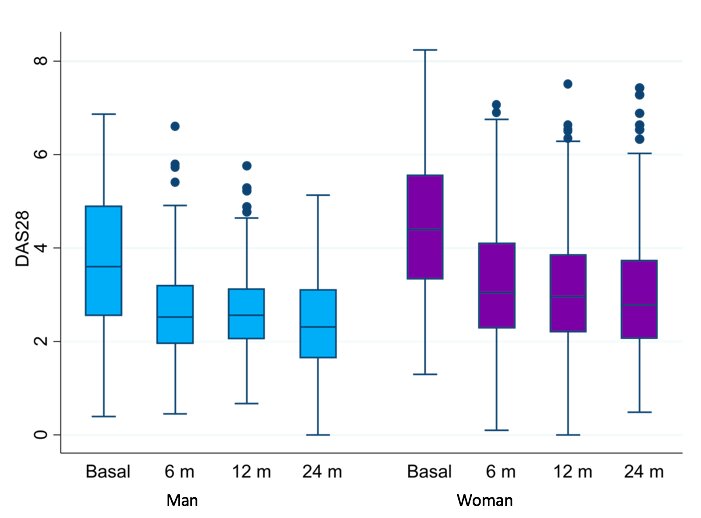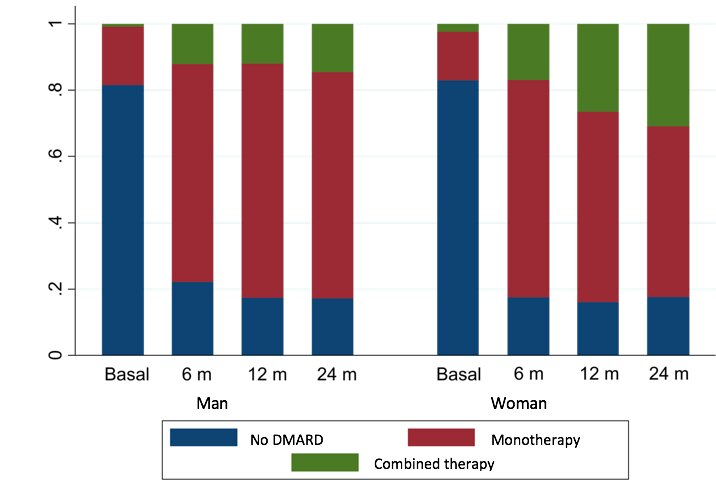Session Information
Date: Monday, November 18, 2024
Title: RA – Treatment Poster III
Session Type: Poster Session C
Session Time: 10:30AM-12:30PM
Background/Purpose: Nowadays the honing in on sex-specific treatment options is the most productive way to move forward with the larger effort of implementing precision medicine. This study described changes in the management of patients depending on their gender.
Objectives:
To analyze, from a gender perspective, potential sex differences in pharmacological prescription to patients with recent-onset arthritis (ROA).
Methods: Retrospective study of use of disease-modifying antirheumatic drugs (DMARD) and corticosteroids (CS) using a registry of patients with ROA of a tertiary hospital, between 2001 and 2023. Demographic, clinical, analytical and treatment data, including dose and reasons of suspension were collected in a protocolized manner at 5 consecutive visits (baseline, 6, 12, 24 and 60 month). Only patients who met the criteria for rheumatoid arthritis (RA) or undifferentiated arthritis (UA) were included. The statistical analysis was performed with the Stata 14.1, using the appropriate tests according to the types and distribution of variables.
Results: 616 patients were included (80% women), 71% RA and 29% UA, with no significant differences by sex. The median (p25-p75) age was 62.7 (51.8-69.9) years in men and 53.7 (42.7-64.7) in women (p=0.0001), with no significant differences in the presence of rheumatoid factor (RF, 54%) and cyclic citrullinated peptide (CCP, 51%). The frequency of non-smokers was higher in women (56% vs 38%; p< 0.001), with a higher body mass index (BMI) in men (p=0.0001). Baseline disease activity was significantly higher in women with DAS-28-VSG (p=0.0001) and HAQ disability (p=0.0001). The median until the first DMARD was 6 months (3 – 10.6), with no differences by sex. The trend was detected towards more frequent use of Hydroxychloroquine (HCQ) in women (26% vs 19%; p=0.08) and biological DMARD (16% vs 10%; p=0.08), along with significantly higher prescription of combined therapy (51.7% vs 39%; p=0.01). We did not find significant differences for Methotrexate (MTX), Leflunomide (LEF), Sulfasalazine (SSZ) or Cyclosporin A (CSA), neither in percentage of cases nor in the dose used. We did not find significant differences in the rates or causes of suspension of MTX, LEF and SSZ, but a tendency for discontinuation was greater in men. Despite less disability, the use of CS on the first visit was more frequent in men (33.6% vs 23.2%; p=0.018), without differences by age (p=0.42) and with significantly higher doses vs women (p90, 15mg vs 10mg). Although the cumulative dose at 2 years was similar. In women, the use of CS was significantly lower in those < 45 and 45-65 years old vs >65 years (p=0.0019).
Conclusion: In our ROA cohort, we detected differences by sex in the use of some DMARD and CS, which cannot be explained only by the degree of activity, disability, or the causes of drug suspension.
The greater use of combination therapy or biological treatment in women could be due to routine use of DAS-28-VSG, a gender-biased index (pain, ESR) that can magnify activity, or as a result, lower initial use and lower dose of CS.
Even though the doses of CS in men could be explained by a higher BMI, it is possible that younger women are more reluctant to use it, despite greater disability.
To cite this abstract in AMA style:
Nikitsina M, Ahijón Lana M, González-Álvaro I. Differences in Pharmacological Prescription to Patients with Recent-onset Arthritis: Analysis from the Gender Perspective [abstract]. Arthritis Rheumatol. 2024; 76 (suppl 9). https://acrabstracts.org/abstract/differences-in-pharmacological-prescription-to-patients-with-recent-onset-arthritis-analysis-from-the-gender-perspective/. Accessed .« Back to ACR Convergence 2024
ACR Meeting Abstracts - https://acrabstracts.org/abstract/differences-in-pharmacological-prescription-to-patients-with-recent-onset-arthritis-analysis-from-the-gender-perspective/



